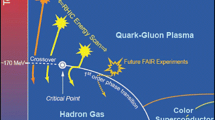Abstract
We propose a better differential method for the computation of the equation of state of QCD from lattice simulations. In contrast to the earlier differential method, our technique yields positive pressure for all temperatures including the temperatures in the transition region. Employing it on temporal lattices of 8, 10 and 12 sites and by extrapolating to zero lattice spacing we obtained the pressure, energy density, entropy density, specific heat and speed of sound in quenched QCD for 0.9 ≤ T/T c ≤ 3. At high temperatures comparisons of our results are made with those from the dimensional reduction approach and also with those from a conformal symmetric theory.
Similar content being viewed by others
References
PHENIX Collaboration: K Adcox et al, Nucl. Phys. A757, 184 (2005)
BRAHMS Collaboration: I Arsene et al, Nucl. Phys. A757, 1 (2005)
PHOBOS Collaboration: B B Back et al, Nucl. Phys. A757, 28 (2005)
STAR Collaboration: J Adams et al, Nucl. Phys. A757, 102 (2005)
G Boyd et al, Phys. Rev. Lett. 75, 4169 (1995); Nucl. Phys. B469, 419 (1996)
R V Gavai, S Gupta and S Mukherjee, Phys. Rev. D71, 074013 (2005)
S Gupta, Phys. Lett. B597, 57 (2004)
S Gupta, Pramana — J. Phys. 61, 877 (2003)
P Arnold and C Zhai, Phys. Rev. D50, 7603 (1994); ibid D51, 1906 (1995)
E Braaten and A Nieto, Phys. Rev. D53, 3421 (1996)
K Kajantie et al, Phys. Rev. Lett. 86, 10 (2001); J. High Energy Phys. 0304, 036 (2003)
A Peshier, Nucl. Phys. A702, 128 (2002)
J O Andersen et al, Phys. Rev. D66, 085016 (2002)
J-P Blaizot, E Iancu and A Rebhan, Phys. Rev. D63, 065003 (2001)
K Kajantie et al, Phys. Rev. Lett. 86, 10 (2001)
A Dumitru, J Lenaghan and R D Pisarski, Phys. Rev. D71, 074004 (2005)
B Grossman et al, Nucl. Phys. B417, 289 (1994)
K Kajantie et al, Phys. Rev. Lett. 79, 3130 (1997)
S Datta and S Gupta, Nucl. Phys. B534, 392 (1998)
M Laine and O Philipsen, Phys. Lett. B459, 259 (1999)
S Datta and S Gupta, Phys. Rev. D67, 054503 (2003)
A Hart, M Laine and O Philipsen, Nucl. Phys. B586, 443 (2000)
QCD-TARO Collaboration: P de Forcrand et al, Phys. Rev. D63, 054501 (2001)
S S Gubser, I R Klebanov and A A Tseytlin, Nucl. Phys. B534, 202 (1998)
I R Klebanov, hep-th/0009139
P Kovtun, D T Son and A Starinets, J. High Energy Phys. 0310, 064 (2003)
D Teaney, Phys. Rev. C68, 034913 (2003)
A Nakamura and S Sakai, Phys. Rev. Lett. 94, 072305 (2005)
H B Meyer, Phys. Rev. D76, 101701 (2007); ibid. arXiv:0710.3717[hep-lat]
J Engels et al, Nucl. Phys. B205, 545 (1982)
Y Deng, Nucl. Phys. (Proc. Suppl.) B9, 334 (1989)
J Engels, J Fingberg, F Karsch, D Miller and M Weber, Nucl. Phys. B252, 625 (1990)
W H Press et al, Numerical recipes (Cambridge University Press, Cambridge, 1986)
S Ejiri, Y Iwasaki and K Kanaya, Phys. Rev. D58, 094505 (1998)
L Stodolsky, Phys. Rev. Lett. 75, 1044 (1995)
R S Bhalerao, J P Blaizot, N Borghini and J Y Ollitrault, Phys. Lett. B627, 49 (2005)
We thank Igor Klebanov for pointing out that the factor x −3/2 in the right-hand side of eq. (1) appears in early literature as (2x)−3/2 due to a different normalization of g 2 N c
See, for example, L D Landau and E M Lifschitz, Fluid mechanics (Reed Elsevier Plc, Oxford, 1998) p. 254
R V Gavai and A Gocksch, Phys. Rev. D33, 614 (1986)
See, for example, S Aoki et al, Nucl. Phys. (Proc. Suppl.) B106, 477 (2002)
A Hasenfratz and P Hasenfratz, Nucl. Phys. B193, 210 (1981)
F Karsch, Nucl. Phys. B205, 285 (1982)
S Datta and R V Gavai, Phys. Rev. D60, 034505 (1999)
S Gupta, Phys. Rev. D64, 034507 (2001)
G P Lepage and P B Mackenzie, Phys. Rev. D48, 2250 (1993)
R G Edwards, U M Heller and T R Klassen, Nucl. Phys. B517, 377 (1998)
U M Heller and F Karsch, Nucl. Phys. B251, 254 (1985)
We thank Kari Rummukainen, Keijo Kajantie and Jürgen Engels for discussions on this point
J Engels, F Karsch and T Scheideler, Nucl. Phys. B564, 303 (2000)
S Datta and S Gupta, Phys. Lett. B471, 382 (2000)
O Kaczmarek et al, Phys. Rev. D62, 034021 (2001)
K Kajantie et al, Phys. Rev. D67, 105008 (2003)
L Lyons, Statistics for nuclear and particle physicists (Cambridge University Press, Cambridge, 1992)
Author information
Authors and Affiliations
Corresponding author
Rights and permissions
About this article
Cite this article
Gavai, R.V., Gupta, S. & Mukherjee, S. Lattice quantum chromodynamics equation of state: A better differential method. Pramana - J Phys 71, 487–508 (2008). https://doi.org/10.1007/s12043-008-0126-9
Received:
Revised:
Accepted:
Published:
Issue Date:
DOI: https://doi.org/10.1007/s12043-008-0126-9




